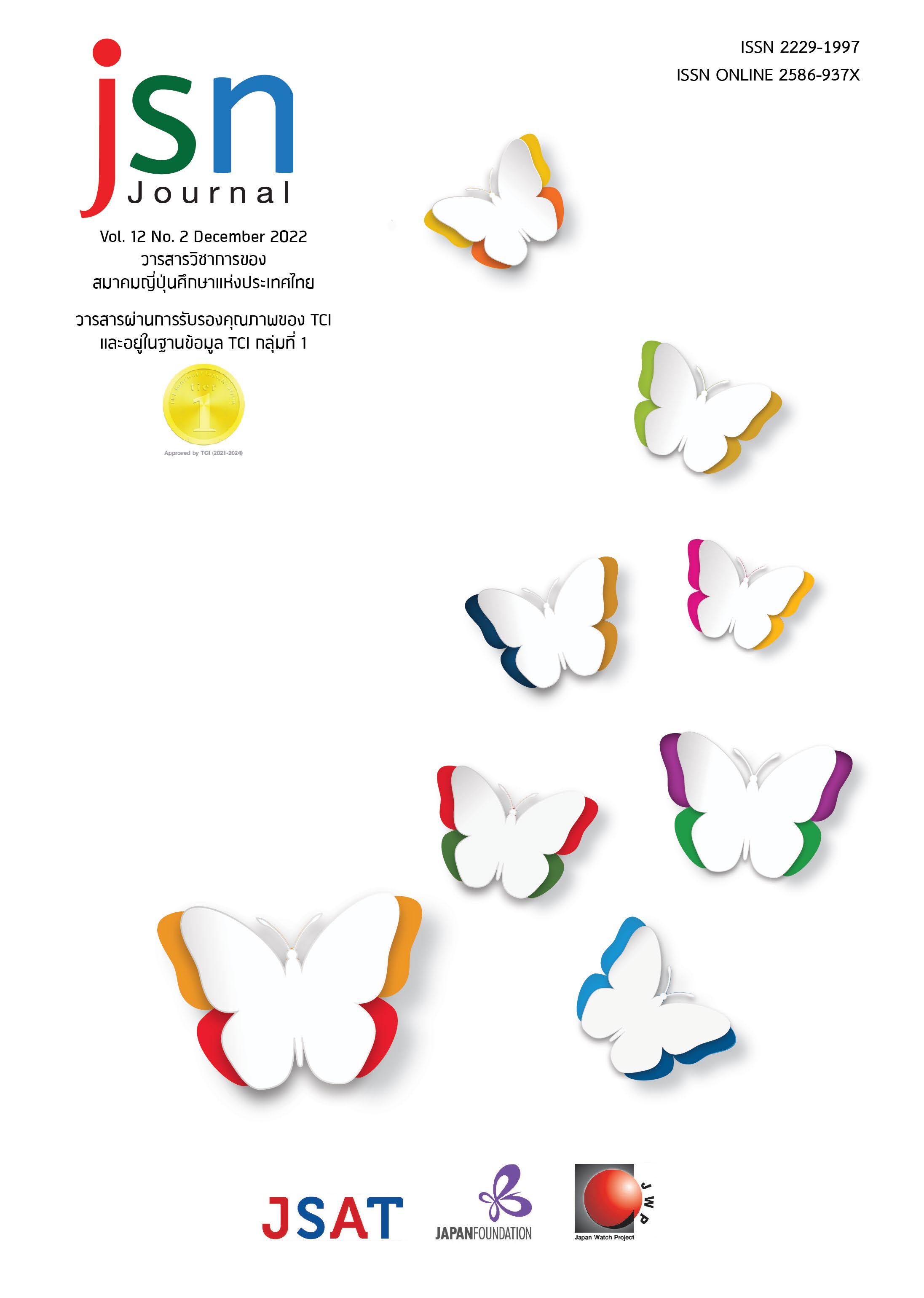Attitudes toward Wearing a Face Mask and Its Effects on Interpersonal Communication: A Comparison between Thai and Japanese People
Main Article Content
Abstract
This study aims to identify and compare the behaviors of Thai and Japanese people while wearing a face mask in conversation and their respective attitudes in this matter and its effects on interpersonal communication. An online questionnaire was used to collect data from 527 Thais and 397 Japanese. The results show that the behaviors and attitudes toward wearing a face mask were different between the Thai and Japanese respondents. Before the COVID-19 crisis, the Japanese had used face masks on various occasions. During the pandemic, both Thai and Japanese people formed negative attitudes toward wearing a face mask due to subsequent inconvenience and discomfort when talking through the mask; however, the Japanese respondents tended to have more positive attitudes in this regard. Yet, both parties believed that wearing a face mask affected the quality of communication as they needed to make more effort when talking with a face mask on, for example, enunciating more clearly and loudly, listening with close attention, and reading the body language of the speaker more frequently. The Thai respondents felt they needed to make special efforts to communicate more than their Japanese counterparts did. It is likely that Japanese people are more accustomed to wearing a face mask than Thai people are and thus find it less difficult to talk with a face mask on. Additionally, Thai and Japanese people tend to interpret facial expressions differently in that the former have more difficulties interpreting facial expressions without seeing the other speaker’s mouth, but the latter find it more difficult to interpret without seeing the person’s eyes. The study implies that wearing a face mask is more likely to affect the feelings and interpersonal communication of Thai people than their Japanese counterparts.
Article Details

This work is licensed under a Creative Commons Attribution-NonCommercial-NoDerivatives 4.0 International License.
ข้อความและข้อคิดเห็นต่างๆ ในบทความเป็นของผู้เขียนบทความนั้นๆ ไม่ใช่ความเห็นของกองบรรณาธิการหรือของวารสาร jsn Journal
References
เกศรินทร์ ทหารเสือ และคณะ. (2552). มุมมองของนิสิตคณะสาธารณสุขศาสตร์ที่มีผลต่อพฤติกรรมการใช้หน้ากากอนามัย (การศึกษาด้วยตัวเอง หลักสูตรปริญญาสาธารณสุขศาสตร์, มหาวิทยาลัยนเรศวร). http://nuir.lib.nu.ac.th/dspace/bitstream/123456789/4549/1/KesarinThahansuea.pdf
ทิพย์ประภา ตันศิริสิทธิกุล และคณะ. (2550). โครงการรณรงค์การใช้หน้ากากอนามัยในโรงพยาบาลปี 2550. สำนักโรคติดต่อทั่วไป กรมควบคุมโรค. ค้นจาก http://odpc9.ddc.moph.go.th/SRRTcenter/mask01.pdf
ทีมข่าวกรุงเทพธุรกิจออนไลน์. (2565). รู้ที่มา ‘หน้ากากอนามัย’ พร้อมเปิดนวัตกรรมใหม่สู้ภัย ‘COVID’. กรุงเทพธุรกิจ. ค้นจาก https://www.bangkokbiznews.com/lifestyle/870235
สมบูรณ์ ขอสกุล. (2564). ปัจจัยที่มีความสัมพันธ์กับพฤติกรรมการใช้หน้ากากอนามัยแบบผ้าในการป้องกันโควิด-19 ของประชาชนในจังหวัดปทุมธานี. วารสารพยาบาลสาธารณสุข, 35(2). 22-38.
ศีลาวุธ ดำรงศิริ.(2562). หน้ากากกันฝุ่น กับ PM2.5. วารสารสิ่งแวดล้อม. 23(1).1-4. ค้นจาก http://www.ej.eric.chula.ac.th/content/6109/63
Burgoon, J. K. et al. (2010). Nonverbal Communication. Boston, MA: Allyn & Bacon.
Carbon, C-C. (2020) .Wearing Face Masks Strongly Confuses Counterparts in Reading Emotions. Frontiers in Psychology. 11: 566886. https://doi.org/10.3389/fpsyg.2020.566886
Ekman, P. (2004). Emotional and Conversational Nonverbal Signals. In Jesus M. Larrazabal and Luis A. Pérez Miranda (Ed.), Language, Knowledge, and Representation. (pp.39-50). Kluwer Academic Publishers.
Ekman, P. (2009). Darwin’s contributions to our understanding of emotional expressions. Philosophical Transactions of the Royal Society B, 364, 3449-3451.
Geangu, E. et al. (2016). Culture shapes 7-month-olds’ perceptual strategies in discriminating facial expressions of emotion. Current Biology Magazine, 26. R663-664. https://doi.org/10.1016/j.cub.2016.05.072
Guarnera, M., Hichy, Z., Cascio, M.I. & Carrubba, S. (2015). Facial Expressions and Ability to Recognize Emotions from Eyes or Mouth in Children. Europe’s Journal of Psychology. 11(2), 183-196. https://doi.org/10.5964/ejop.v11i2.890
Hall, E.T. (1976). Beyond Culture. Doubleday Dell Publishing.
Jack, R.E., Garrod, O.G.B., Yu, H., Caldara, R., and Schyns, P.G. (2012). Facial Expressions of Emotion are not Culturally Universal. Proceedings of the National Academy of Sciences. 109(19), 7241-4. https://www.researchgate.net/publication/224052915_Facial_expressions_of_emotion_are_not_culturally_universal
Marini, M., Ansani, A.,Paglieri, F., Caruana, F. and Viola, M. (2021). The impact of facemask on emotion recognition, trust attribution and re-identification. Scientific Reports.11, 5577. https://doi.org/10.1038/s41598-021-84806-5
Matsumoto, D., (1991). Cultural Influences on Facial Expression of Emotion. The Southern Communication Journal. 56, 128-137. https://doi.org/10.1080/10417949109372824
Mheidly, N. et al. (2020). Effect of Face Masks on Interpersonal Communication during the COVID-19 Pandemic. Frontiers in Public Health. 8, 1-6. https://doi.org/10.3389/fpubh.2020.582191
Molnar-Szakacs, I., Uddin, L. Q., and Heffenan, M.B. (2021). The face behind the mask: The future of interpersonal interaction. Neuron, 109(12), 1918-1920. https://doi.org/10.1016/j.neuron.2021.05.030
Ong, S. (2020, June 9). How face masks affect our communication. BBC Future. Retrieved from https://www.bbc.com/future/article/20200609-how-face-masks-affect-our-communication
Yang, J.A. (2014, November 19). A quick history of why Asians wear surgical masks in public. QUARTZ. Retrieved from https://qz.com/299003/a-quick-history-of-why-asians-wear-surgical-masks-in-public
朝日新聞(2020).「マスク社会 程よい距離感」2020年8月7日朝, 23.
笠置遊(2017).「マスク着用は対人不安者のコミュニケーションを促すか」日本心理学会, 第81回大会予稿集, p.73. https://doi.org/10.4992/pacjpa.81.0_1B-009
笠置遊(2020).「サングラスの着用が対人コミュニケーションに及ぼす影響」日本心理学会, 第84回大会予稿集, p.51. https://doi.org/10.4992/pacjpa.84.0_PC-156
北多摩薬剤師会(2021). 日本のマスクの歴史概説 日本のマスクの歴史と、独特な「マスク文化」の形成について」おくすり博物館余話. https://www.tpa-kitatama.jp/museum/museum_yowa2.html
金益美(2020).「マスク社会 程よい距離感」読売新聞大阪朝刊2020年8月7日, 23.
The Asahi Shimbun Globe+ (2021).「なぜアジア人と欧米人でマスクへの意識が違うのか 専門家が教える、その科学的裏付け」2021年02月13日. https://globe.asahi.com/article/14183725
柴崎全弘(2018).「表情の読み取り方に見る文化差~日本人は目 欧米人は口~」中部経済新聞2018年4月18日. https://www.ngu.jp/media/180418_ChuKei_Opinion_Assoc.-Prof.Shibasaki.pdf
日本経済新聞(2020).「マスクの歴史 呼吸器・高級品・ガーゼ・使い捨て…」2020年3月29日. https://www.nikkei.com/article/DGXMZO57052560Q0A320C2W11600/


